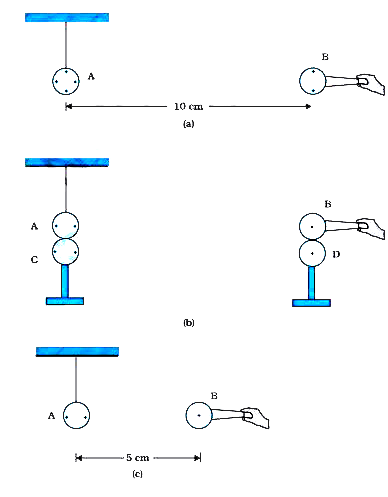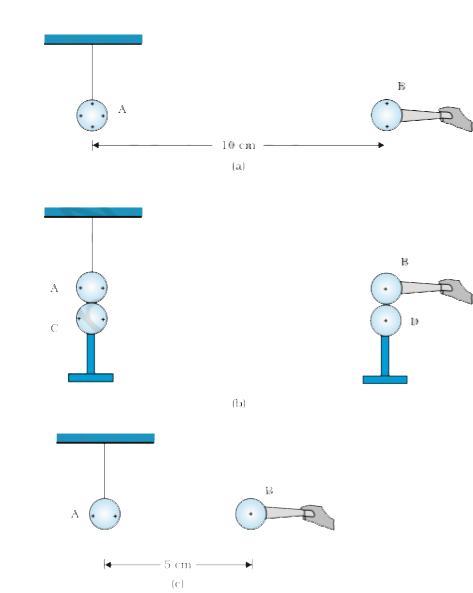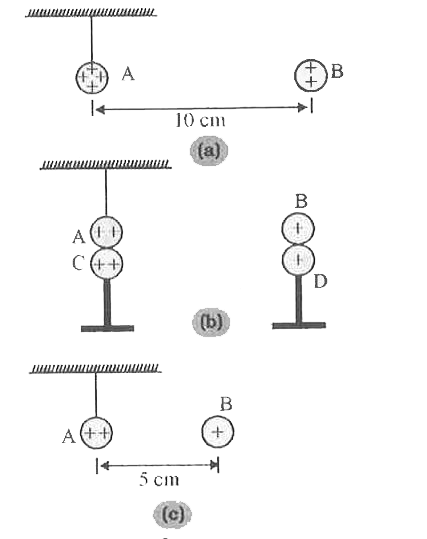A charged metallic sphere A is suspended by a nylon thread another charged metallic sphere b held by an insulating centers is 10 cm as shown in Fig. 1.7(a). The resulting repulsion of A is noted (for example, by shining a beam of light and measuring the deflection of its shadow on a screen). Spheres A and B are touched by uncharged spheres C and D respectively, as shown in Fig. 1.7(b). C and D are then removed and B is brought closer to A to a distance of 5.0 cm between their centers, as shown in Fig. 1.7(c). What is the expected repulsion of A on the basis of Coulomb’s law? Spheres A and C and spheres B and D have identical sizes. ignore the sizes of a and b in comparison to the separation between their centers
 Solution in Gujrati
Solution in Gujrati
Let the original charge on spere a be q and that on b be q at a distance r beteen their centres the magnitude of the F=14πε0qqr2
neglecting the sizes of sperhers a and b in comparions to r when an identical but unchanged spere c touches a the charges redisitribute on a and c and by symmetry each sprere carries a charge q/2 similary after d touches b the rredistributed charge on each is of the electrosatic force on each is
F=14πε0(q/2)(q/2)(r/2)2=14πε0qqr2=F
Thus the electrostatic force on a due to b remains unaltered
Topper's Solved these Questions
- BOOK - NCERT GUJARATICHAPTER - ELECTRIC CHARGES AND FIELDS EXERCISE - EXERCISES34videos
ELECTRIC CHARGES AND FIELDS
- BOOK - NCERT GUJARATICHAPTER - DUAL NATURE OF RADIATION AND MATTEREXERCISE - EXERCISES41videos
DUAL NATURE OF RADIATION AND MATTER
- BOOK - NCERT GUJARATICHAPTER - ELECTROMAGNETIC INDUCTIONEXERCISE - ADDITIONAL EXERCISES7videos
ELECTROMAGNETIC INDUCTION
Similar Questions
What is the force between two small charged speres having charges of 2×10−7 c and 3×10−7 c placed 30 cm apart in air
03:13View SolutionFind the
(a) maximum frequency, and
(b) minimum wavelength of X-rays produced by 30 kv electrons.03:28View SolutionSuppose the loop is stationary but the current feeding the electromagnet that produces the magnetic field is gradually reduced so that the field decreases from its initial value of 0.3 T at the rate of 0.02 T s−1. If the cut is joined and the loop has a resistance of 1.6 Ω, how much power is dissipated by the loop as heat ? What is the source of this power ?
02:59View SolutionA metal sphere is suspended from a nylon thread. Initially, the metal sphere is uncharged. When a positively charged glass rod is brought close to the metal sphere, the sphere is drawn towards the rod. But if the sphere touches the rod, it suddenly flies away from the rod. Explain, why the sphere is first attracted then repelled?
02:59View SolutionConsider three identical metal spheres A,B and C. Spheres A carres charge +6q carries no charge . Spheres A and B are touchd together and them separated. Sphere C is then touched to sphere A and separated from it . Finally the sphere C is touched to sphere B and separated from it . Find the final chage on the sphere C.
05:29View SolutionA charged metallic sphere A is suspended by a nylon thread. Another charged metallic sphere B held by an insulating handle is brought close to A such that the distance between their centres is 10 cm, as shown in Fig. 1.7(a). The resulting repulsion of A is noted (for example, by shining a beam of light and measuring the deflection of its shadow on a screen). Spheres A and B are touched by uncharged spheres C and D respectively, as shown in Fig. 1.7(b). C and D are then removed and B is brought closer to A to a distance of 5.0 cm between their centres, as shown in Fig. 1.7(c). What is the expected repulsion of A on the basis of Coulomb’s law? Spheres A and C and spheres B and D have identical sizes. Ignore the sizes of A and B in comparison to the separation between their centres.
 06:27View Solution
06:27View SolutionA charged metallic sphere A is suspended by a nylon thread. Another charged metallic sphere B held by an insulating handle is brought close to A such that the distance between their centres is 10 cm, as shown in Fig. 1.7(a). The resulting repulsion of A is noted (for example, by shining a beam of light and measuring the deflection of its shadow on a screen). Spheres A and B are touched by uncharged spheres C and D respectively, as shown in Fig. 1.7(b). C and D are then removed and B is brought closer to A to a distance of 5.0 cm between their centres, as shown in Fig. 1.7(c). What is the expected repulsion of A on the basis of Coulomb’s law? Spheres A and C and spheres B and D have identical sizes. Ignore the sizes of A and B in comparison to the separation between their centres.
 02:01View Solution
02:01View SolutionThree metal spheres A,B and C are mounted on insulating stands. The spheres are touching one another, as shown in the diagram A strong positively charged object it brought near sphere A and a strong negative charge is brought near sphere C. While the charged objects remains near spheres A anc C, sphere B is removed by means of its insulating stand. After the charged objects are removed, sphere B is first touched to sphere A and then to sphere C. The resulting charge on B would be-
07:14View Solutionधातु का आवेशित गोला A नायलॉन के धागे से निलंबित है। विद्युतरोधी हत्थी द्वारा किसी अन्य धातु के आवेशित गोले B को A के इतने निकट लाया जाता है कि चित्र (a) में दर्शाए अनुसार इनके केंद्रों के बीच की दूरी 10cm गोले के परिणामी प्रतिकर्षण को नोट किया जाता है (उदाहरणार्थ-गोले पर चमकीला प्रकाश पुंज डालकर तथा अंशांकित पर्दे पर बनी इसकी छाया का विक्षेपण मापकर)। A तथा B गोलों को चित्र (b) में दर्शाए अनुसार क्रमशः अनावेशित गोलों C तथा D से स्पर्श कराया जाता है। तत्पश्चात् चित्र (c) में दर्शाए अनुसार C तथा D को हटाकर B को A के इतना निकट लाया जाता है कि इनके केंद्रों के बीच की दूरी 5.0 cm हो जाती है। कूलॉम नियम के अनुसार A का कितना अपेक्षित प्रतिकर्षण है? गोले A तथा C एवं गोले B तथा D के साइज सर्वसम हैं। A तथा B के केंद्रों के पृथक्कन की तुलना में इनके साइजों की उपेक्षा कीजिए।
 06:27View Solution
06:27View Solutionधातु के एक गोले A पर +10μC आवेश है। इसे दूसरे समान गोले B से स्पर्श कराया जाता है। गोले A पर कितना आवेश रह जायेगा ?
01:33View SolutionA charged metalic sphere A is suspended by a nylon thread. Another charged metallic sphere B held by an insulating handle is brought close to A such that the distance between their centres is 10 cm, as shown in Fig. (a). The resulting repulsion of A is noted (for example, by shining a beam of light and measuring the deflection of its shadow on a screen). Spheres A and B are touched by uncharged spheres C and D respectively, as shown in Fig. (b). C and D are then removed and B is brought closer to A to distance of 5.0 cm between their centres, as shown in Fig. (c). what is the expected repulsion of A on the basis of Coulomb's law? Spheres A and C and spheres B and D have identical sizes. Ignore the size of A and B in comparison to the separation between their centres.
04:07View Solutionधातु का आवेशित गोला A नायलॉन के धागे से निलंबित है। विद्युतरोधी हत्थी द्वारा किसी अन्य धातु के आवेशित गोले B को A के इतने निकट लाया जाता है कि चित्र (a) में दर्शाए अनुसार इनके केंद्रों के बीच की दूरी 10cm गोले के परिणामी प्रतिकर्षण को नोट किया जाता है (उदाहरणार्थ-गोले पर चमकीला प्रकाश पुंज डालकर तथा अंशांकित पर्दे पर बनी इसकी छाया का विक्षेपण मापकर)। A तथा B गोलों को चित्र (b) में दर्शाए अनुसार क्रमशः अनावेशित गोलों C तथा D से स्पर्श कराया जाता है। तत्पश्चात् चित्र (c) में दर्शाए अनुसार C तथा D को हटाकर B को A के इतना निकट लाया जाता है कि इनके केंद्रों के बीच की दूरी 5.0 cm हो जाती है। कूलॉम नियम के अनुसार A का कितना अपेक्षित प्रतिकर्षण है? गोले A तथा C एवं गोले B तथा D के साइज सर्वसम हैं। A तथा B के केंद्रों के पृथक्कन की तुलना में इनके साइजों की उपेक्षा कीजिए।
 07:23View Solution
07:23View SolutionTwo uncharged conducting spheres, A and B, are suspended from insulating threads so that they touch each other as shown in the figure. While a negatively charged rod is held near, but not touching sphere A, someone moves ball B away from A. How will the spheres be charged, if at all ?
05:13View SolutionA charged metallic sphere A is suspended by a nylon thread. Another charged metallic sphere B held by an insulating handle is brought close to A such that the distance between their centres is 10 cm, as shown in Fig. 1.7(a). The resulting repulsion of A is noted (for example, by shining a beam of light and measuring the deflection of its shadow on a screen). Spheres A and B are touched by uncharged spheres C and D respectively, as shown in Fig. 1.7(b). C and D are then removed and B is brought closer to A to a distance of 5.0 cm between their centres, as shown in Fig. 1.7(c). What is the expected repulsion of A on the basis of Coulomb’s law? Spheres A and C and spheres B and D have identical sizes. Ignore the sizes of A and B in comparison to the separation between their centres.
 04:49View Solution
04:49View SolutionA charged metallic sphere A is suspended by a nylon thread. Another charged metallic sphere B held by an insulating handle is brought close to A such that the distance between their centres is 10 cm, as shown in figure (a). The resulting repulsion of A is noted (for example, by shining a beam of light and measuring the deflection of its shadow on a screen). Spheres A and B are touched by uncharged spheres C and D respectively, as shown in figure (b). C and D are then removed and B is brought closer to A to a distance of 5.0 cm between their centres, as shown in figure (c). What is the expected repulsion of A on the basis of Coulomb's law ? Spheres A and C and spheres B and D have identical sizes. Ignore the sizes of A and B in comparison to the separation between their centres.
06:44View Solution

